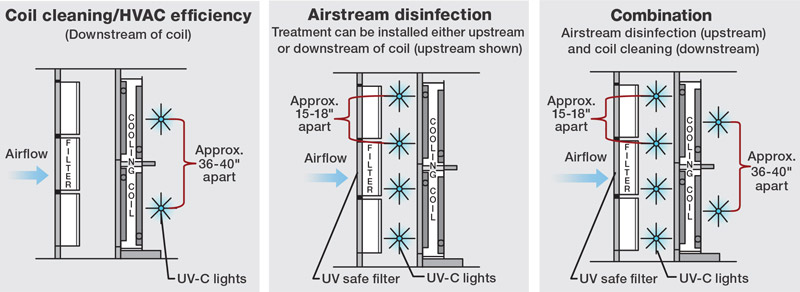UV Sanitation: The Cutting-Edge Technology Transforming Cleanliness Practices
In the realm of sanitation techniques, one innovation has arised as a game-changer: UV disinfection. From healthcare setups to food processing, UV sanitation is making its mark in various sectors.
Exactly How UV Disinfection Functions
UV disinfection functions by utilizing ultraviolet light to damage or inactivate microorganisms, supplying a extremely effective and chemical-free method of hygiene. This technology harnesses the power of short-wavelength UV-C light, which is qualified of damaging the DNA and RNA of microorganisms, hence rendering them incapable to duplicate and cause injury.
The process begins with the installment of UV disinfection systems, which contain UV lights that give off UV-C light. These lights are strategically put in areas where microbial contamination is a worry, such as water therapy plants, healthcare facilities, research laboratories, and food handling centers.
When microbes are exposed to UV-C light, the photons permeate their cell walls and reach the DNA and RNA inside. The high-energy UV-C photons interfere with the genetic product by developing bonds in between nearby nucleotides, leading to the formation of thymine dimers. These dimers avoid the bacteria from replicating, rendering them safe.
UV sanitation is very efficient versus a wide variety of bacteria, including bloodsuckers, infections, and bacteria. It is especially efficient against waterborne microorganisms like E. coli, Giardia, and Cryptosporidium. UV sanitation is a chemical-free approach, removing the requirement for potentially damaging anti-bacterials and lowering the danger of damaging disinfection byproducts.
Benefits of UV Sanitation
UV sanitation provides numerous benefits in the area of cleanliness, making it a highly favored technique for successfully getting rid of damaging microorganisms. Among the crucial benefits of UV sanitation is its ability to provide a chemical-free solution. Unlike typical disinfection techniques that count on chemicals, UV sanitation utilizes ultraviolet light to destroy the DNA of microorganisms, rendering them incapable to recreate and cause infections. This not just gets rid of the need for possibly hazardous chemicals but additionally decreases the threat of chemical deposit on surfaces.

UV sanitation is also extremely functional in its applications. It can be made use of in different settings, consisting of healthcare facilities, institutions, food handling facilities, and water therapy plants. UV disinfection systems can be quickly incorporated into existing cleanliness techniques, supplying an additional layer of defense against transmittable diseases.
In enhancement to its effectiveness and flexibility, UV sanitation is additionally ecologically pleasant. It does not produce any type of harmful results or residues, making it a risk-free and sustainable method for sanitation - uv surface disinfection. In addition, UV disinfection needs very little upkeep and has a lengthy life-span, causing cost financial savings in the future.
UV Sanitation in Health Care Setups
In healthcare settings, UV disinfection has emerged as an innovative method for properly removing hazardous microbes. UV disinfection functions by producing ultraviolet light at a details wavelength that is lethal to germs, viruses, and various other bacteria.
To start with, UV disinfection is a non-chemical technique, making it an environmentally friendly alternative contrasted to conventional sanitation methods that often involve using harsh chemicals. Using UV light removes the need for chemical anti-bacterials, reducing the risk of hazardous residue or chemical direct exposure to both people and medical care workers.
Additionally, UV disinfection is highly effective in eliminating a variety of microbes, consisting of drug-resistant bacteria such as MRSA and C. difficile. It offers a reliable and constant sanitation procedure, ensuring that all surface areas and devices are thoroughly decontaminated, also in hard-to-reach areas.

UV Disinfection in Food Handling
The application of UV disinfection extends beyond medical care setups and locates considerable worth in the realm of food processing. uv surface disinfection. UV disinfection modern technology is ending up being progressively popular in the food industry as a result of its capability to successfully get rid of damaging microorganisms and boost food safety
Among the primary benefits of UV sanitation in food processing is its capability to target a wide variety of microbes, including infections, molds, and germs. By utilizing UV light at details wavelengths, it is feasible to disrupt the DNA and RNA of these virus, making them incapable to create or duplicate damage. This innovation can site link be applied to numerous stages of the food processing chain, including surface disinfection, tools sterilization, and water therapy.
UV sanitation offers a non-thermal and chemical-free technique of sanitizing foodstuff. Unlike standard sanitation approaches that depend on chemicals or warmth, UV technology does not leave any kind of deposit or alter the preference, texture, or dietary value of the food. This makes it a suitable service for markets have a peek at these guys that call for stringent adherence to top quality requirements.
Moreover, UV disinfection systems are easy to install and operate, needing minimal upkeep. They can be integrated right into existing handling lines without triggering considerable interruptions to the production procedure. Additionally, UV systems have a fast therapy time, enabling for continuous handling and reducing downtime.
The Future of UV Disinfection

One location where UV sanitation is anticipated to make considerable developments is in the field of healthcare. With the rise of antibiotic-resistant bacteria and the requirement for extra effective disinfection techniques, UV light has the potential to play an important role in minimizing healthcare-associated infections. UV sanitation systems can be utilized to decontaminate surface areas, tools, and also the air in health care facilities, assisting to protect against the spread of dangerous pathogens and boost individual safety.
An additional market that could gain from improvements in UV sanitation technology is the food market. UV light has already confirmed to be an effective technique for sanitizing foodstuff and reducing the risk of foodborne ailments. As technology improves, we can expect to see much more effective and affordable UV disinfection systems being this hyperlink applied in food processing plants, making certain that the food we eat is safe and cost-free from unsafe microorganisms.
Verdict
In conclusion, UV disinfection is a cutting-edge innovation that is transforming cleanliness methods in health care settings and food handling. By utilizing UV light to eliminate or shut down bacteria, it offers various benefits such as security, efficiency, and effectiveness. With recurring improvements in this field, UV sanitation holds terrific prospective for the future of cleanliness, providing a reliable and lasting solution for maintaining clean and hygienic settings.
UV disinfection is a chemical-free method, eliminating the need for potentially hazardous anti-bacterials and lowering the risk of unsafe sanitation spin-offs.
Unlike typical sanitation techniques that rely on chemicals, UV sanitation makes use of ultraviolet light to destroy the DNA of microorganisms, rendering them unable to duplicate and create infections. Unlike typical disinfection techniques that count on chemicals or warm, UV modern technology does not leave any residue or change the preference, structure, or dietary worth of the food. As innovation boosts, we can expect to see much more cost-effective and reliable UV sanitation systems being executed in food processing plants, guaranteeing that the food we consume is secure and complimentary from harmful germs.
In verdict, UV disinfection is a cutting-edge modern technology that is changing sanitation methods in health care setups and food handling.
 Joshua Jackson Then & Now!
Joshua Jackson Then & Now! Barry Watson Then & Now!
Barry Watson Then & Now! Earvin Johnson III Then & Now!
Earvin Johnson III Then & Now! Bo Derek Then & Now!
Bo Derek Then & Now! Atticus Shaffer Then & Now!
Atticus Shaffer Then & Now!